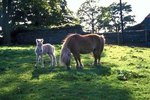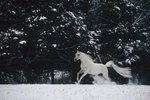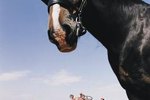The horse and buggy often is the first thing people look for when entering Amish country. While there is no restriction on the horse breeds the Amish use, former standardbred racehorses are the most common for pulling buggies, and draft horses usually work the fields.
Standardbreds

The standardbred mainly is bred for use in harness racing. While they have the ability to canter, they generally have been trained to trot or pace. Because a racing standardbred already has been broken to pull a cart, it is a perfect candidate for hitching to an Amish family's buggy. The standardbred is known for having an even disposition, which is important as Amish horses often are on roads with a lot of traffic. In addition, standardbreds are obtained fairly cheaply as owners of unsuccessful harness racers often look for ways to unload excess animals.
American Saddlebred

The American saddlebred is another breed commonly used to pull a buggy. This is a fairly sturdy breed, with a naturally flashy, knee-snapping gait. The American saddlebred originally was bred to be driven and ridden on plantations in the South. Today, it still is shown in driving classes as well as under saddle. In addition to its flashy gaits, the American saddlebred has a reputation for having a good disposition and willingness to please. Saddlebreds have become less popular in recent years and in some areas of the United States, the Amish have been able to pick up this horse fairly inexpensively.
Draft Horses

The Amish do not use tractors or other machines in their fields. Instead, they rely on a draft horse or a team of draft horses to pull plows and other farm equipment. The most common draft-horse breeds are the Percheron and the Belgian draft horse. Both are powerful, hardworking, docile breeds. In Pennsylvania, donkeys sometimes are bred to Belgians, with the resulting foal being a strong, large mule popular with the Amish in the Lancaster County area. Mules are not used by Amish in Ohio and some other Midwestern states because they once were forbidden by the Amish Ministers' Conference for being an inappropriate mixing of donkey and horse blood, and thus being a creature not originally created by God.
Haflingers

Haflingers are stocky, muscular horses that resemble Belgians but are much smaller, standing between 13 and 15 hands. Belgian draft horses stand between 17 and 18 hands. The Haflinger, which originated in Austria is an easy keeper, works hard and has the ability to pull a buggy or be teamed to pull a large plow or other heavy vehicle. It is a gentle breed, and its compact size makes it easier for a small adult or child to work with than some of the large draft horses. While most large draft horses are uncomfortable to ride, the Haflinger is well suited to being a mount.
References
Photo Credits
-
nilapictures/iStock/Getty Images




